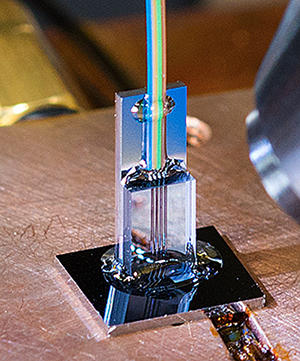PML Priority: Photonics

Precision control and detection of light now play an indispensable role in advanced manufacturing, high-speed digital communications, health care technology, defense, and research in fields from laser welding to cell biology. Photonics is the basis for devices from cell phone cameras and night-vision goggles to optical fiber networks for the Internet, sensors used in assembling cars and airplanes, and techniques for the diagnosis and treatment of disease.
The United States has historically been the world leader in deploying photonics research for cutting-edge technologies, but global competition has put this leadership at risk, causing a substantial U.S. loss of market share and jobs to overseas competitors. Ensuring American pre-eminence in photonics demands substantial improvements in our ability to generate and sense light at ever smaller dimensions, shorter time scales, and lower intensities.
That is why NIST's Physical Measurement Laboratory (PML) has made photonics a major priority for the near future. In particular, we are committed to progress in (i) photonic metrology and technology for industry, (ii) application of high-intensity light sources in manufacturing and materials processing, and (iii) the use of photonics for health care. Each is described in detail on the pages linked below.
- Metrology for Advanced Manufacturing
- Advanced Measurement Science for the Application of Intense Light Sources in Manufacturing and Materials Processing
- Advanced Photonics for Health Care
NIST will enhance partnerships with the U.S. manufacturing sector to develop and disseminate test methods, measurement tools and know-how, and scientific data that are embedded in the processes, products, and services of nearly every U.S. manufacturing industry.
PML's photonics focus is also consistent with the NIST 2016-2018 Three-year Programmatic Plan, especially as it applies to "advanced sensing for manufacturing," and with the recommendations of numerous expert advisory groups.
A recent report from the National Research Council suggests the potential breadth and significance of improved photonics capabilities including:
. . . electronic imaging devices implantable in the eye which can restore sight to the blind; cost-effective, laser-based, three-dimensional desktop printing of many different types of objects; the generation, detection, and manipulation of single photons in the same way as is done with single electrons, and doing it all on a photonic integrated circuit; the use of optics as interconnects between integrated circuit chips, with dramatic increases in power efficiency and speed; the unfurling of a flexible display on a smartphone or the watching of holographic images at home; and the ability of mobile lasers to neutralize threats from afar with high accuracy and speed.
A 2014 report prepared by the National Science and Technology Council identified four urgent priorities for research opportunities in optics and photonics – the top two of which are reflected in the PML priority effort:
- Biophotonics to Advance Understanding of Systems Biology and Disease Progression: Support fundamental research in innovative biophotonics to enable advances in quantitative imaging; systems biology, medicine, and neuroscience; in vivo validation of biomarkers that advance medical diagnostics, prevention, and treatment; and more efficient agricultural production.
- From Faint to Single Photonics: Develop optics and photonics technologies that operate at the faintest light levels . . . [and] . . . Exotic Photonics: Promote research and development to make compact coherent sources, detectors, and associated optics at exotic wavelengths and to make them accessible to academia, national laboratories, and industry.
PML's photonics initiative also bears upon another important national need: communications bandwidth. North American telecommunication capacity grew by a factor of 100 over the last decade alone, and demand for additional bandwidth is expected to continue at a rate of about 40 percent per year. Integrated photonic circuits will be a critical competitive differentiator for applications ranging from telecommunications networks to data-center links to computer and on-processor interconnects, because the technology offers higher transmission speed and data capacity at lower energy per bit than exclusively electronic interconnects.

